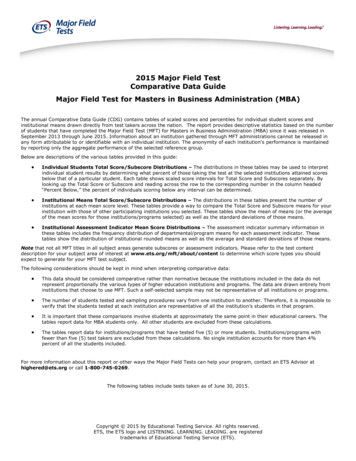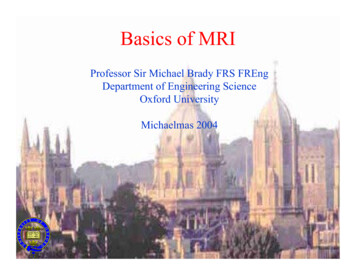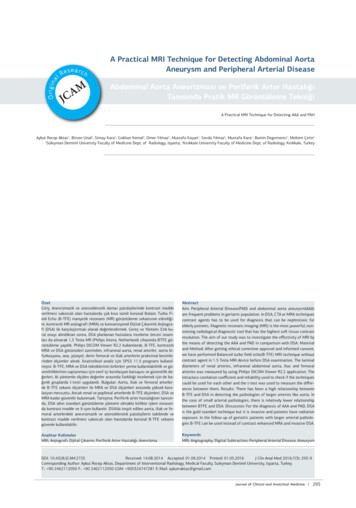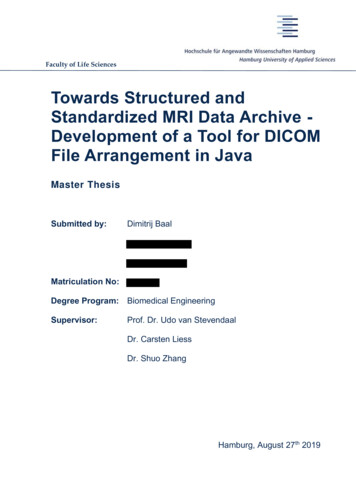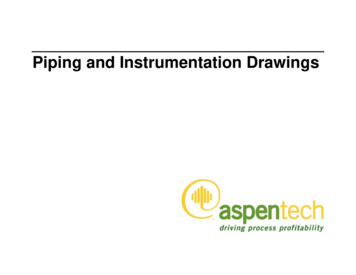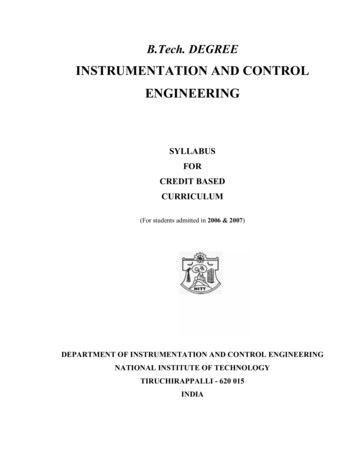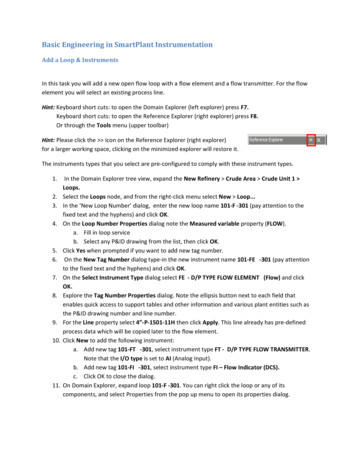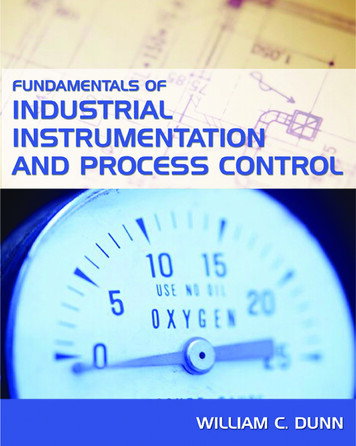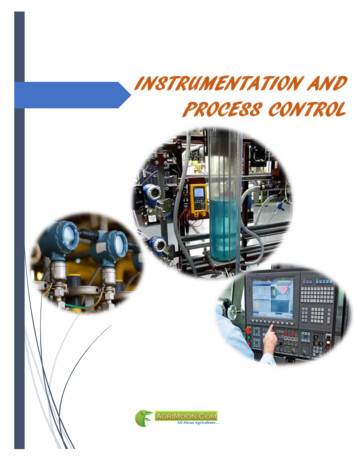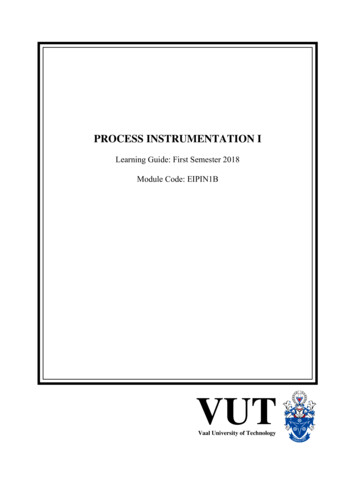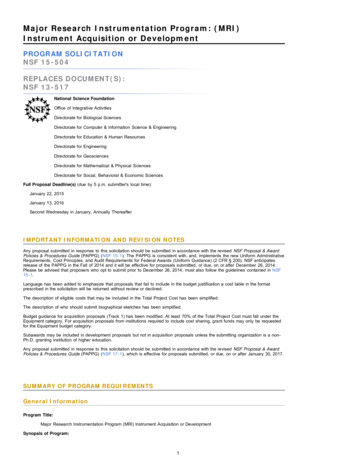
Transcription
Major Research Instrumentation Program: (MRI)Instrument Acquisition or DevelopmentPROGRAM SOLICITATIONNSF 15-504REPLACES DOCUMENT(S):NSF 13-517National Science FoundationOffice of Integrative ActivitiesDirectorate for Biological SciencesDirectorate for Computer & Information Science & EngineeringDirectorate for Education & Human ResourcesDirectorate for EngineeringDirectorate for GeosciencesDirectorate for Mathematical & Physical SciencesDirectorate for Social, Behavioral & Economic SciencesFull Proposal Deadline(s) (due by 5 p.m. submitter's local time):January 22, 2015January 13, 2016Second Wednesday in January, Annually ThereafterIMPORTANT INFORMATION AND REVISION NOTESAny proposal submitted in response to this solicitation should be submitted in accordance with the revised NSF Proposal & AwardPolicies & Procedures Guide (PAPPG) (NSF 15-1). The PAPPG is consistent with, and, implements the new Uniform AdministrativeRequirements, Cost Principles, and Audit Requirements for Federal Awards (Uniform Guidance) (2 CFR § 200). NSF anticipatesrelease of the PAPPG in the Fall of 2014 and it will be effective for proposals submitted, or due, on or after December 26, 2014.Please be advised that proposers who opt to submit prior to December 26, 2014, must also follow the guidelines contained in NSF15-1.Language has been added to emphasize that proposals that fail to include in the budget justification a cost table in the formatprescribed in the solicitation will be returned without review or declined.The description of eligible costs that may be included in the Total Project Cost has been simplified.The description of who should submit biographical sketches has been simplified.Budget guidance for acquisition proposals (Track 1) has been modified. At least 70% of the Total Project Cost must fall under theEquipment category. For acquisition proposals from institutions required to include cost sharing, grant funds may only be requestedfor the Equipment budget category.Subawards may be included in development proposals but not in acquisition proposals unless the submitting organization is a nonPh.D. granting institution of higher education.Any proposal submitted in response to this solicitation should be submitted in accordance with the revised NSF Proposal & AwardPolicies & Procedures Guide (PAPPG) (NSF 17-1), which is effective for proposals submitted, or due, on or after January 30, 2017.SUMMARY OF PROGRAM REQUIREMENTSGeneral InformationProgram Title:Major Research Instrumentation Program (MRI) Instrument Acquisition or DevelopmentSynopsis of Program:1
The Major Research Instrumentation Program (MRI) serves to increase access to shared scientific and engineeringinstruments for research and research training in our Nation's institutions of higher education, not-for-profitmuseums, science centers and scientific/engineering research organizations. The program provides organizationswith opportunities to acquire major instrumentation that supports the research and research training goals of theorganization and that may be used by other researchers regionally or nationally.Each MRI proposal may request support for the acquisition (Track 1) or development (Track 2) of a single researchinstrument for shared inter- and/or intra-organizational use. Development efforts that leverage the strengths ofprivate sector partners to build instrument development capacity at MRI submission-eligible organizations areencouraged.The MRI program assists with the acquisition or development of a shared research instrument that is, in general,too costly and/or not appropriate for support through other NSF programs. The program does not fund researchprojects or provide ongoing support for operating or maintaining facilities or centers.The instrument acquired or developed is expected to be operational for regular research use by the end of theaward period. For the purposes of the MRI program, a proposal must be for either acquisition (Track 1) ordevelopment (Track 2) of a single, well-integrated instrument. The MRI program does not support the acquisitionor development of a suite of instruments to outfit research laboratories or facilities, or that can be used to conductindependent research activities simultaneously.Instrument acquisition or development proposals that request funds from NSF in the range 100,000- 4 millionmay be accepted from any MRI-eligible organization. Proposals that request funds from NSF less than 100,000may also be accepted from any MRI-eligible organization for the disciplines of mathematics or social, behavioraland economic sciences and from non-Ph.D.-granting institutions of higher education for all NSF-supporteddisciplines.Cost-sharing of precisely 30% of the total project cost is required for Ph.D.-granting institutions of highereducation and for non-degree-granting organizations. Non-Ph.D.-granting institutions of higher education areexempt from cost-sharing and cannot include it. National Science Board policy is that voluntary committed costsharing is prohibited.Please see the solicitation text for definitions of organizational types used by the MRI program.Cognizant Program Officer(s):Please note that the following information is current at the time of publishing. See program website for any updates to the points ofcontact.Randy L. Phelps, telephone: (703) 292-5049, email: rphelps@nsf.govApplicable Catalog of Federal Domestic Assistance (CFDA) atical and Physical SciencesGeosciencesComputer and Information Science and EngineeringBiological SciencesSocial Behavioral and Economic SciencesEducation and Human ResourcesOffice of International Science and EngineeringOffice of Integrative Activities (OIA)Award InformationAnticipated Type of Award:Standard GrantEstimated Number of Awards:160Proposals that request funds from NSF in the range 100,000- 4 million may be accepted from any MRI-eligible organization.Proposals that request funds from NSF less than 100,000 may also be accepted from any MRI-eligible organization for thedisciplines of mathematics or social, behavioral and economic sciences, and from non-Ph.D.-granting institutions of higher educationfor all NSF-supported disciplines.Anticipated Funding Amount: 75,000,000Proposals submitted in response to this program solicitation will be competing for about 75 million, pending availability of funds andquality of proposals. Up to 30 million of these funds will be available to support proposals requesting 1- 4 million from NSF,depending on overall proposal pressure and quality.Eligibility InformationWho May Submit Proposals:Proposals may only be submitted by the following:Organizations that may apply for the MRI program:Submission Eligibility2
Proposals may only be submitted by organizations located in the United States, its territories orpossessions, as follows:1. Institutions of higher education (Ph.D.-granting and non-Ph.D.-granting), acting on behalf of theirfaculty members, that are accredited in and have a campus in the United States, its territories orpossessions. Distinct academic campuses (e.g., that award their own degrees, have independentadministrative structures, admissions policies, alumni associations, etc.) within multi-campus systemsqualify as separate submission-eligible institutions. (Campuses or organizations that plan to submit aproposal through the Sponsored Projects Office of other campuses or organizations should contact NSFto discuss eligibility as early as possible and at least six weeks before submitting such a proposal.)2. Not-for-profit, non-degree-granting domestic U.S. organizations, acting on behalf of their employees,that include (but are not limited to) independent museums and science centers, observatories, researchlaboratories, professional societies, and similar organizations that are directly associated with the Nation'sresearch or educational activities. These organizations must have an independent, permanentadministrative organization (e.g., a sponsored projects office) located in the United States, its territories orpossessions, and have 501(c)(3) tax status.3. To facilitate access to unique instrumentation for a broad user base of U.S. scientists and engineers,and to encourage collaboration and sharing of state-of-the-art instrumentation, the MRI program acceptsproposals from consortia of organizations. Consortium proposals may be submitted as follows:3a. Legally incorporated, not-for-profit consortia including two or more submission-eligible organizationsas described in items (1) and (2) above may submit proposals on behalf of the consortium. The coversheet must clearly indicate the consortium nature of the proposal in the title. Such a consortium is onewith an independent administrative structure (e.g., a Sponsored Projects Office) located in the UnitedStates, its territories or possessions and 501(c)(3) status.3b. Submission-eligible organizations as described in items (1) and (2) above may submit proposals onbehalf of consortia. The cover sheet must clearly indicate the consortium nature of the proposal in thetitle, and it must identify a PI and co-PI(s) from at least two MRI submission-eligible organizationsparticipating in the consortium. These consortium proposals may also include as partners U.S.organizations that are not eligible to submit MRI proposals.4. Commercial U.S. organizations, especially small businesses with strong capabilities in scientific orengineering research or education, are eligible for instrument development support only throughsubawards as private sector partners with submitting organizations; they may not submit proposals. Suchpartnerships must be substantive and meaningful, and build capacity for instrument development withinMRI submission-eligible organization(s). Title to the resulting instrument should be retained by thesubmitting organization(s). Commercial organizations must be based in the United States, its territories orpossessions.Prospective PIs may contact the cognizant MRI program officers regarding organizational eligibility, andfor information on other NSF funding opportunities for instrumentation; see also Section IX for a list ofrelated NSF programs for research instrumentation.Additionally:MREFC-related Proposals: The MRI program will not accept proposals for an instrument thataugments an NSF Major Research Equipment and Facilities Construction (MREFC) project if thatproject is not receiving operations funding outside of the MREFC account.FFRDC-related Proposals: Proposals for the acquisition or development of an instrument to belocated at a facility of another Federal agency or one of their Federally Funded Research andDevelopment Centers (FFRDCs) must be submitted as a consortium proposal by an MRIsubmission-eligible organization as described in item 3(b) above. The proposal must include thefacility/FFRDC (or its managing organization) as a partner in the consortium, even if the role ofthe FFRDC in the project is solely to house the instrument. The instruments must make uniquecontributions to the needs of researchers elsewhere or establish access to new multi-userfacilities. The current list of FFRDCs can be found at: ry inquiry to the cognizant MRI point of contact should be made before preparing aproposal for submission.Organization CategoriesAll MRI-eligible organizations belong to one of the following three categories:A. Ph.D.-granting institutions of higher education are accredited colleges and universities that haveawarded more than 20 Ph.D or D.Sc. degrees in all NSF-supported fields during the combined previoustwo academic years. Additionally, any organization that awards Ph.D. or D.Sc. degrees in NSF-supportedfields is considered to be a Ph.D.-granting institution if the only degrees it awards in NSF-supported fieldsare post-Bachelor's degrees.B. Non-Ph.D.-granting institutions of higher education are accredited colleges and universities(including two-year community colleges) that award Associate's degrees, Bachelor's degrees, and/orMaster's degrees in NSF-supported fields, but have awarded 20 or fewer Ph.D./D.Sc. degrees in all NSFsupported fields during the combined previous two academic years.C. Non-degree-granting organizations are those that do not award Associate's degrees, Bachelor'sdegrees, Master's degrees, and/or Ph.Ds. or Ds.Sc. Non-degree-granting organizations also includeinstitutions of higher education that award all of their degrees outside of NSF-supported fields.Please review NSF's Guide to Programs for NSF-supported fields of science, mathematics andengineering at http://www.nsf.gov/funding/browse all funding.jsp.Who May Serve as PI:There are no restrictions or limits.3
Limit on Number of Proposals per Organization:Three (3) as described below. Potential PIs are advised to contact their institutional office of research regardingprocesses used to select proposals for submission.If three proposals are submitted, at least one of the proposals must be for instrument development (i.e., no morethan two proposals may be for instrument acquisition).To ensure a balanced instrumentation award portfolio at diverse organizations, across varied research topics, andin support of a broadly inclusive science and engineering workforce across the entire Nation, the MRI programrequires that an MRI-eligible organization may, as a performing organization, submit or be included as asignificantly funded 1 subawardee in no more than three MRI proposals. To promote instrumentation development,the program requires that if an organization submits or is included as a significantly funded1 subawardee in threeMRI proposals, at least one of the three proposals must be for (Track 2) instrument development.NSF reserves the right to carefully examine development (Track 2) proposals to ensure that they meet therequirements for this proposal type (see Section II). If a proposal submitted as development is deemed to be anacquisition proposal either before or during the review, the proposal is subject to return without review or decline.1 An unfunded collaboration does not count against the submission limit. Inclusion as a funded subawardee on adevelopment (Track 2) proposal at a level in excess of 20% of the total budget requested from NSF, or as afunded subawardee on any acquisition (Track 1) proposal, will be counted against an organization's proposalsubmission limit. Separately submitted linked collaborative proposals of either type (Track 1 or Track 2) countagainst the submission limit of each of the submitting organizations. However, if a subaward to an organization ina development (Track 2) proposal is 20% or less of the proposal's total budget request from NSF, thesubawardee's submission limit will not be affected. For subawards within a linked collaborative proposal, the 20%threshold applies to the budget request from NSF in the proposal containing the subaward(s), not to the combinedbudget request from NSF for the collaborative project.Note: The 30% cost-sharing requirement applies to only the portion of the total project cost budgeted to nonexempt organizations, including those participating through subawards. When required, cost-sharing must beprecisely 30%. Cost sharing is required for Ph.D.-granting institutions of higher education and for non-degreegranting organizations. Non-Ph.D.-granting institutions of higher education are exempt from cost-sharing andcannot provide it. National Science Board policy is that voluntary committed cost sharing is prohibited. See sectionV.B. for specific information on cost-sharing calculations and the solicitation text for definitions of organizationaltypes used for the MRI program.Limit on Number of Proposals per PI or Co-PI:There are no restrictions or limits.Proposal Preparation and Submission InstructionsA. Proposal Preparation InstructionsLetters of Intent: Not requiredPreliminary Proposal Submission: Not requiredFull Proposals:Full Proposals submitted via FastLane: NSF Proposal and Award Policies and Procedures Guide (PAPPG)guidelines apply. The complete text of the PAPPG is available electronically on the NSF website at:https://www.nsf.gov/publications/pub summ.jsp?ods key papp.Full Proposals submitted via Grants.gov: NSF Grants.gov Application Guide: A Guide for the Preparation andSubmission of NSF Applications via Grants.gov guidelines apply (Note: The NSF Grants.gov Application Guide isavailable on the Grants.gov website and on the NSF website at: http://www.nsf.gov/publications/pub summ.jsp?ods key grantsgovguide).B. Budgetary InformationCost Sharing Requirements:Cost Sharing is required. Please see the full text of this solicitation for further information.Indirect Cost (F&A) Limitations:Not ApplicableOther Budgetary Limitations:Other budgetary limitations apply. Please see the full text of this solicitation for further information.C. Due DatesFull Proposal Deadline(s) (due by 5 p.m. submitter's local time):January 22, 2015January 13, 2016Second Wednesday in January, Annually ThereafterProposal Review Information Criteria4
Merit Review Criteria:National Science Board approved criteria. Additional merit review considerations apply. Please see the full text of this solicitation forfurther information.Award Administration InformationAward Conditions:Standard NSF award conditions apply.Reporting Requirements:Additional reporting requirements apply. Please see the full text of this solicitation for further information.TABLE OF CONTENTSSummary of Program RequirementsI. IntroductionII. Program DescriptionIII. Award InformationIV. Eligibility InformationV. Proposal Preparation and Submission InstructionsA. Proposal Preparation InstructionsB. Budgetary InformationC. Due DatesD. FastLane/Grants.gov RequirementsVI. NSF Proposal Processing and Review ProceduresA. Merit Review Principles and CriteriaB. Review and Selection ProcessVII. Award Administration InformationA. Notification of the AwardB. Award ConditionsC. Reporting RequirementsVIII. Agency ContactsIX. Other InformationI. INTRODUCTIONA. Program GoalsThe Major Research Instrumentation (MRI) Program serves to increase access to shared instrumentation for scientific andengineering research and research training in our Nation's institutions of higher education and not-for-profit-museums, sciencecenters and scientific/engineering research organizations. The program seeks to improve the quality and expand the scope ofresearch and research training in science and engineering, by providing organizations with opportunities to acquire instrumentationthat supports the research and research training goals of the organization. The program emphasizes shared-use instrumentation thatwill enhance the capabilities of researchers both within and outside the proposing organization. Development efforts that leverage thestrengths of private sector partners to build instrument development capacity at MRI submission-eligible organizations areencouraged.The MRI Program is intended to assist with the acquisition or development of a single research instrument that is, in general, toocostly and/or not appropriate for support through other NSF programs. An instrument acquired or developed with support from theMRI program is expected to be operational for regular research use by the end of the award period. The program does not fundresearch projects, including research that uses an instrument acquired or developed with support from the program. The programdoes not support the operation and maintenance of facilities or centers.Proposals to the MRI Program, must be for either acquisition (Track 1) or development (Track 2), and must be for only a single,well-integrated instrument. A well-integrated research instrument means that the ensemble of equipment that defines the instrumentenables a specific research experiment or type of research experimen
are post-Bachelor's degrees. B. Non-Ph.D.-granting institutions of higher education are accredited colleges and universities (including two-year community colleges) that award Associate's degrees, Bachelor's degrees, and/or Master's degrees in NSF-supported fields, but have awarded 20
